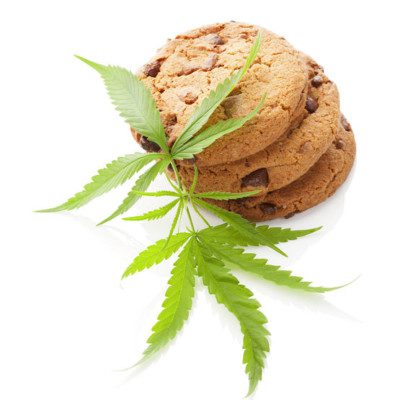Origin
Cannabis sativa L plant is an ancient crop which was cultivated for medicinal uses in China over 4500 years ago. The earliest mention of edibles can be traced back to 1954 in the recipe book “Hashish Fudge” by Alice B Toklas. Demand for cannabis infused food products increased dramatically since 2013. Despite approvals in Canada and Europe for incorporating edibles in food products, some legal hurdles still restrict such practices in the US.2,3
Function
Justification for cannabinoids-containing edibles is centered around their potential medicinal benefits. Other aspects include their distinct greenish color and robust aroma associated with terpenes or other flavonoids present in the plant.3
Nutrition
The nutritional profile of cannabis edibles is equivalent to that of hemp seed and oil. Hemp is a good source of high-quality protein—mainly albumin and edestin—and essential amino acids. Its unique essential fatty acids composition may contribute to cholesterol reduction and heart health.3
Consumption of edibles has been associated with pain relief, anti-inflammatory and antidepressant properties of THC and CBD.3 Bioavailability of cannabinoids is dependent on the person’s weight, metabolism and the presence of food in the digestive system.1
Commercial production4
Edibles are usually made from cannabinoids concentrates. A typical commercial process involves:
- Crushing: dried cannabis leaves are crushed into a fine powder
- Extraction: using supercritical CO2 as a solvent
- Winterization: mixing oil extracts with alcohol and freezing
- Filtration: removal of undesirable fractions
- Evaporation: heating the oil-alcohol mixture to remove and recuperate the alcohol.
- Distillation: crude oil is distilled to remove unwanted compounds and retain high oil purity
Application3,5
Some considerations need to be taken into account when manufacturing cannabis infused baked goods, such as:
- Source: purchase from a reliable source and known purity.
- Fat medium: when using CBD oil, it should be mixed with the lipid components of the formula such as oil, butter or ghee for even distribution. In some recipes, the fat medium may be substituted by a liquor like rum or vodka.
- Concentration: determine the THC or CBD content of the dose before baking.
- Temperature: due to its heat sensitivity, cannabinoid oil may be added after cooking to avoid oxidizing the oil.
- Serving size: it is important to accurately calculate the serving size and cannabinoids oil dosing.
Daily dose guidance for a 150 pound adult:3
| Source of Cannabis | Dose |
| Leaf or plant trim (10% THC) | 0.25-1.5 g |
| Bud (15-20% THC) | 0.125-0.75 g |
| Kief/hashish (high THC) | 0.062-0.5 g |
For successful baking with cannabis concentrates, it is important to start with small doses to determine its impact. Incremental increases should be small and continuously monitored. The psychoactive effects of THC may vary between beginners and experienced consumers.3
A general guideline for cannabis dosing in baked goods:
| Baked good | Dosing / serving | Level |
| Pancakes5 | 5 mg of CBD oil | Low |
| Muffin5 | 8-12 mg of CBD oil | Medium |
| Carrot Cake5 | 8-17 mg of CBD oil | Medium |
| Cinnamon Donuts5 | 25-42 mg of CBD oil | High |
| Brownie3 | ¼ cup of THC oil | – |
| Chocolate Chip Cookies3 | ½ cup of THC butter | – |
| Banana Bread3 | ½ cup of THC butter | – |
FDA regulations
Cannabis derived compounds are not permitted to be sold as supplements or added to food products by the FDA, according to the Federal, Food, Drug and Cosmetic Act.6
References
- Charlebois, S, Music, J, Sterling, B & Somogyi, S. “Edibles And Canadian Consumers’ Willingness To Consider Recreational Cannabis In Food Or Beverage Products: A Second Assessment”. Trends In Food Science & Technology, vol 98, 2020, pp. 25-29. Elsevier BV, doi:10.1016/j.tifs.2019.12.025.
- Lawrence, R.G. Pot In Pans: A History Of Eating Cannabis. 1st ed., Rowman & Littlefield, 2019, pp. 80-85.
- Wedman-St.Louis, B. Cannabis: A Clinician’s Guide. 1st ed., CRC Press, 2020, pp. 160-174.
- Gibraltar Industries. “How To Extract CBD Oil – The Extraction Process & How CBD Oil Is Made – Apeks Supercritical”. Apeks Supercritical, 2020,
- Petitto, M. (Ed). The CBD Handbook: Over 75 Recipes For Hemp-Derived Health And Wellness. 1st ed., Chartwell Books, 2019.
- U.S. Department of Health and Human Services and U.S. Department of Agriculture. “FDA Regulation of Cannabis and Cannabis-Derived Products, Including Cannabidiol (CBD)”. March 2020. Available at https://www.fda.gov/news-events/public-health-focus/fda-regulation-cannabis-and-cannabis-derived-products-including-cannabidiol-cbd. Accessed 12 May 2020.

